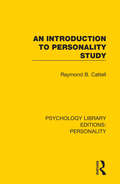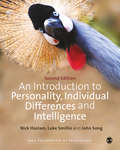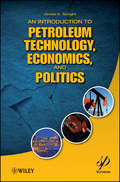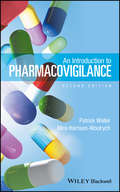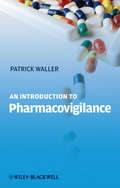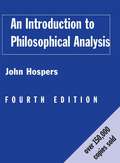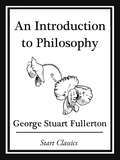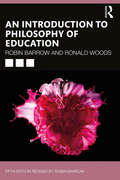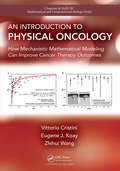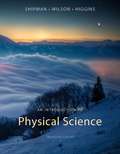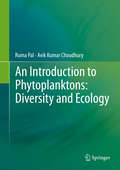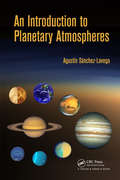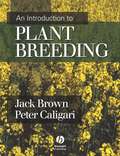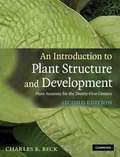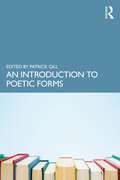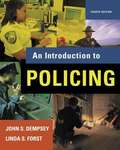- Table View
- List View
An Introduction to Personality Study (Psychology Library Editions: Personality #4)
by Raymond B. CattellOriginally published in 1950, the need for a small standard text on basic principles of personality structure and development had been very apparent to teachers of psychology for some time. There were many books illustrating specialized or applied aspects of the psychology of personality – such as abnormal psychology, educational psychology, child psychology, mental measurement, vocational guidance, etc. – but lacking was a treatment of personality study as pure psychology, concentrating on the fundamentals. The aim of this title was therefore to bring the general problems of personality description and development, normal and abnormal, into a single perspective and to integrate the principle fields of observation in clear cut generalizations.
An Introduction to Personality, Individual Differences and Intelligence (SAGE Foundations of Psychology series)
by Nick Haslam Dr John Song Dr Luke SmillieThe second edition of this popular textbook builds on the strengths of the first, continuing its reputation for clarity, accessibility, conceptual sophistication and panoramic coverage of personality and intelligence. The authorship team is enriched by the addition of two high-profile international scholars, Luke Smillie and John Song, whose expertise broadens and deepens the text. New to this edition: Chapters exploring the neurobiological, genetic and evolutionary foundations of personality; and emotion, motivation and personality processes An enhanced coverage of personality disorders A thoroughly revised and extended section on intelligence which now addresses cognitive abilities and their biological bases; the role of intelligence in everyday life; and emotional intelligence A brand new companion website that includes a substantial test bank and lecture slides. An Introduction to Personality, Individual Differences and Intelligence, Second Edition is a key textbook for all psychology students on a personality or individual differences course.
An Introduction to Personality, Individual Differences and Intelligence (SAGE Foundations of Psychology series)
by Nick Haslam Dr John Song Dr Luke SmillieThe second edition of this popular textbook builds on the strengths of the first, continuing its reputation for clarity, accessibility, conceptual sophistication and panoramic coverage of personality and intelligence. The authorship team is enriched by the addition of two high-profile international scholars, Luke Smillie and John Song, whose expertise broadens and deepens the text. New to this edition: Chapters exploring the neurobiological, genetic and evolutionary foundations of personality; and emotion, motivation and personality processes An enhanced coverage of personality disorders A thoroughly revised and extended section on intelligence which now addresses cognitive abilities and their biological bases; the role of intelligence in everyday life; and emotional intelligence A brand new companion website that includes a substantial test bank and lecture slides. An Introduction to Personality, Individual Differences and Intelligence, Second Edition is a key textbook for all psychology students on a personality or individual differences course.
An Introduction to Personality, Individual Differences and Intelligence (SAGE Foundations of Psychology series)
by Nick Haslam Luke SmillieWhat does it mean to have a personality? Is emotional intelligence a kind of intelligence? Learn the answers to these questions, as well as everything you need to know about personality, intelligence, and individual differences in the third edition of this clear and accessible textbook. From natural selection to intelligence tests, and from personality disorders to the concept of IQ, the panoramic coverage of this field makes this textbook essential reading for any psychology student on a personality and individual differences course. New to this edition: · Increased coverage of intelligence · ‘Key Theorists’ feature · Discussion questions moved to end-of-chapter to enable in-text assessment Nick Haslam is Professor of Psychology at the University of Melbourne, Australia. Luke Smillie is an Associate Professor of Psychology at the University of Melbourne and director of the Personality Processes Lab.
An Introduction to Personality, Individual Differences and Intelligence (SAGE Foundations of Psychology series)
by Nick Haslam Luke SmillieWhat does it mean to have a personality? Is emotional intelligence a kind of intelligence? Learn the answers to these questions, as well as everything you need to know about personality, intelligence, and individual differences in the third edition of this clear and accessible textbook. From natural selection to intelligence tests, and from personality disorders to the concept of IQ, the panoramic coverage of this field makes this textbook essential reading for any psychology student on a personality and individual differences course. New to this edition: · Increased coverage of intelligence · ‘Key Theorists’ feature · Discussion questions moved to end-of-chapter to enable in-text assessment Nick Haslam is Professor of Psychology at the University of Melbourne, Australia. Luke Smillie is an Associate Professor of Psychology at the University of Melbourne and director of the Personality Processes Lab.
An Introduction to Pet Dental Care: For Veterinary Nurses and Technicians
by Kathy IstacePeriodontal disease is one of the most common diseases observed by small animal practitioners, and it is not uncommon for the veterinary technician to be the first line in oral health assessment and treatment. Despite this, current dentistry training for veterinary technicians and nurses is often very limited. This book explains the causes, consequences, prevention and treatment of pet dental diseases including periodontal disease, fractured teeth, tooth resorption, dental malocclusions, oral masses, jaw fractures, and other oral conditions. It covers: · Instruction in essential skills such as dental cleaning, charting, radiography, and equipment maintenance. · Advanced skills such as the administration of regional nerve blocks and periodontal treatments. · The aetiology and treatment of common oral conditions. Improving competence in veterinary dental skills benefits technicians, veterinary practices, owners and their pets. Explaining pet dental diseases in a relatable way, this book allows veterinary staff to relay important dental information to pet owners in a way they understand. Providing solutions to help prevent and manage pet dental diseases, it outlines treatment options, outcomes, and post-operative dental care.
An Introduction to Petroleum Technology, Economics, and Politics
by James G. SpeightThe perfect primer for both the layperson and the engineer, for the new hire and the old hand, describing, in easy-to-understand language, one of the biggest and most lucrative industries in the world. There is only one substance known to mankind that can cause wars, influence global economies, and make entire countries rich: petroleum. One teaspoon of the stuff carries enough energy to power a ton truck up a hill. It's in the news every single day, it influences our lives in ways that we cannot fathom, and it is the most important commodity in the world. But how much does the average person, even the average engineer, know about it? This book describes the petroleum industry, in easy-to-understand language, for both the layperson and engineer alike. From the economics of searching for oil and gas to the pitfalls of drilling and production, getting it out of the ground, into pipelines, into refineries, and, finally, into your gas tank, this book covers the petroleum industry like no other treatment before. There is coverage of pricing and the economics of this very important resource, as well, which is useful not only to engineers, but to economists and, really, anyone who uses it. From jet fuel to gasoline to natural gas and plastics, petroleum is one of the integral products of our lives. We are practically bathed it in from birth, our food is protected by it, and it even has healing properties. Learn all about this incredible substance and its fascinating history and highly debated future. An Introduction to Petroleum Technology, Economics, and Politics: Gives a thorough summary of the petroleum and natural gas industry, from prospect to production to pipeline New technologies, such as directional and underbalanced drilling, are covered, in easy-to-understand language Useful not only for newcomers and laypersons, but for engineers and students, particularly those for whom English is a second language Examines the basics of pricing and valuation
An Introduction to Pharmacovigilance
by Patrick Waller Mira Harrison-WoolrychPharmacovigilance is the science and activities relating to the detection, assessment, understanding and prevention of adverse effects or any other drug-related problems. This introductory guide is designed to aid the rapid understanding of the key principles of pharmacovigilance. Packed full of examples illustrating drug safety issues it not only covers the processes involved, but the regulatory aspects and ethical and societal considerations of pharmacovigilance. Covering the basics step-by-step, this book is perfect for beginners and is essential reading for those new to drug safety departments and pharmaceutical medicine students. The second edition is thoroughly revised and updated throughout and includes a new chapter on clinical aspects of pharmacovigilance.
An Introduction to Pharmacovigilance
by Patrick WallerPharmacovigilance is the science and activities relating to the detection, assessment, understanding and prevention of adverse effects or any other drug-related problems. This introductory guide is designed to aid the rapid understanding of the key principles of pharmacovigilance. Packed full of examples illustrating drug safety issues it not only covers the processes involved, but the regulatory aspects and ethical and societal considerations of pharmacovigilance. Covering the basics step-by-step, this book is perfect for beginners and is essential reading for those new to drug safety departments and pharmaceutical medicine students.
An Introduction to Phase-Integral Methods (Dover Books on Mathematics)
by John HeadingThe phase-integral method in mathematics, also known as the Wentzel-Kramers-Brillouin (WKB) method, is the focus of this introductory treatment. Author John Heading successfully steers a course between simplistic and rigorous approaches to provide a concise overview for advanced undergraduates and graduate students in mathematics and physics. Since the number of applications is vast, the text considers only a brief selection of topics and emphasizes the method itself rather than detailed applications. The process, once derived, is shown to be one of essential simplicity that involves merely the application of certain well-defined rules. Starting with a historical survey of the problem and its solutions, subjects include the Stokes phenomenon, one and two transition points, and applications to physical problems. An appendix and bibliography conclude the text.
An Introduction to Philosophical Analysis
by John HospersJohn Hospers' Introduction to Philosophical Analysis has sold over 150,000 copies since its first publication. This new edition ensures that its success will continue into the twenty-first century. It remains the most accessible and authoritative introduction to philosophy available using the full power of the problem-based approach to the area to ensure that philosophy is not simply taught to students but practised by them.The most significant change to this edition is to respond to criticisms regarding the omission in the third edition of the famous opening chapter. A brand new chapter, Words and the World, replaces this in the fourth edition - which now features a large number of examples and illustrative dialogues. The rest of the text has been thoroughly revised and updated to take account of recent developments in some areas of philosophy.
An Introduction to Philosophy
by George Stuart FullertonThis anthology is a thorough introduction to classic literature for those who have not yet experienced these literary masterworks. For those who have known and loved these works in the past, this is an invitation to reunite with old friends in a fresh new format. From Shakespeare s finesse to Oscar Wilde s wit, this unique collection brings together works as diverse and influential as The Pilgrim s Progress and Othello. As an anthology that invites readers to immerse themselves in the masterpieces of the literary giants, it is must-have addition to any library
An Introduction to Philosophy of Education
by Robin Barrow Ronald WoodsThis introductory text, now in its fourth edition, is a classic in its field. It shows, first and foremost, the importance of philosophy in educational debate and as a background to any practical activity such as teaching. What is involved in the idea of educating a person or the idea of educational success? What are the criteria for establishing the optimum balance between formal and informal teaching techniques? How trustworthy is educational research? In addition to these questions, which strike to the heart of the rationale for the educative process as a whole, the authors explore such concepts as culture, creativity, autonomy, indoctrination, needs, interests and learning by discovery. In this new updated edition, the authors draw on the latest research in genetics to argue that education is uniquely human and is essentially what develops us as humans. Resisting modern tendencies to equate knowledge with opinion, and value judgements with taste, this book leads the reader into the business of philosophising and champions the cause of reason in education.
An Introduction to Philosophy of Education
by Robin Barrow Ronald WoodsThis introductory text, now in its fifth edition, is a classic in its field. It shows, first and foremost, the importance of philosophy in educational debate and as a background to any practical activity such as teaching. What is involved in the idea of educating a person or the idea of educational success? What are the criteria for establishing the optimum balance between formal and informal teaching techniques? How trustworthy is educational research? In addition to these questions, which strike to the heart of the rationale for the educative process as a whole, the authors explore such concepts as culture, creativity, autonomy, indoctrination, needs, interests, and learning by discovery. Updates to this edition include new chapters on religious education and moral education, as well as questions for reflection at the end of each chapter.
An Introduction to Philosophy: A Christian Guide to the Things that Really Matter
by Steven B. Sherman Richard A. Holland Gary S. Osmundsen Peter J. RasorDesigned for students in Christian colleges and seminaries, An Introduction to Philosophy surveys the four main areas of philosophy - logic, metaphysics, epistemology, and ethics - in an accessible and engaging manner. Yet it also covers important topics sometimes left unaddressed in introductions, including:why philosophy matters in our daycritical thinking and intellectual virtuea brief history of philosophyphilosophical hermeneuticsthe relationship between philosophy, faith, and worldviewreligious epistemologybioethics, sexual ethics, other types of ethicsa Christian philosophy of lifeGrounded in the Christian intellectual tradition, each chapter in An Introduction to Philosophy includes student-friendly features such as chapter summaries, explanatory sidebars, reflection questions, vocabulary words and definitions, and suggestions for further reading. Professors and students will find it to be a broad and useful overview, perfect for undergraduate and seminary students alike.
An Introduction to Physical Oncology: How Mechanistic Mathematical Modeling Can Improve Cancer Therapy Outcomes (Chapman & Hall/CRC Mathematical Biology Series)
by Vittorio Cristini Eugene Koay Zhihui WangPhysical oncology has the potential to revolutionize cancer research and treatment. The fundamental rationale behind this approach is that physical processes, such as transport mechanisms for drug molecules within tissue and forces exchanged by cancer cells with tissue, may play an equally important role as biological processes in influencing progression and treatment outcome. <P><P>This book introduces the emerging field of physical oncology to a general audience, with a focus on recent breakthroughs that help in the design and discovery of more effective cancer treatments. It describes how novel mathematical models of physical transport processes incorporate patient tissue and imaging data routinely produced in the clinic to predict the efficacy of many cancer treatment approaches, including chemotherapy and radiation therapy. By helping to identify which therapies would be most beneficial for an individual patient, and quantifying their effects prior to actual implementation in the clinic, physical oncology allows doctors to design treatment regimens customized to each patient’s clinical needs, significantly altering the current clinical approach to cancer treatment and improving the outcomes for patients.
An Introduction to Physical Science (13th Edition)
by James Shipman Jerry D. Wilson Aaron Todd Charles A. HigginsConsistent with previous editions of An Introduction to Physical Science, the goal of the new Thirteenth edition is to stimulate students' interest in and gain knowledge of the physical sciences. Presenting content in such a way that students develop the critical reasoning and problem-solving skills that are needed in an ever-changing technological world, the authors emphasize fundamental concepts as they progress through the five divisions of physical sciences: physics, chemistry, astronomy, meteorology, and geology. Ideal for a non-science majors course, topics are treated both descriptively and quantitatively, providing instructors the flexibility to emphasize an approach that works best for their students.
An Introduction to Phytoplanktons: Diversity And Ecology
by Ruma Pal Avik Kumar ChoudhuryThe book , 'An Introduction to Phytoplanktons - Diversity and Ecology' is very useful as it covers wide aspects of phytoplankton study including the general idea about cyanobacteria and algal kingdom. It contains different topics related to very basic idea of phytoplanktons such as, types ,taxonomic description and the key for identification etc. Together with it, very modern aspects of phytoplankton study including different methodologies needed for research students of botany, ecology, limnology and environmental biology are also included. The first chapter is very basic and informative and describes algal and phytoplankton classification, algal pigments, algal bloom and their control, algal toxins, wetlands algae, ecological significance of phytoplanktons etc. A general key for identification of common phytoplankton genera is also included for students who will be able to identify these genera based on the light microscopic characters. In Chapters 2-4, different aspects of phytoplankton research like primary productivity, community pattern analysis and their ecological parameter analysis have been discussed with detailed procedures. Statistical analysis is also discussed in detail. Chapter 5 includes case studies related to review, phytoplankton diversity and dynamics.
An Introduction to Place-Based Development Economics and Policy
by Gilberto SeravalliThis book introduces the reader to local development economics and policy, with a special focus on the place-based paradigm that covers its justification, its difficulties and the types of public intervention that it suggests. The starting point for the analysis is that economic development in lagging places is not to be expected as the result of a mechanism of automatic convergence between backward and advanced regions and that, therefore, the most appropriate development policy is not to maximize competition among all agents in all sectors and places. The failure of the Washington Consensus is examined, and the two competing positions to have emerged from this failure - spatially blind interventions and place-based policies - are contrasted. The main shortcoming of spatially blind policies, namely that immobile resources that could trigger or support a development process often remain untapped or "trapped", is emphasized. The limitations of the "big push" state intervention and wage flexibility solutions to this trap are analyzed and the merits of place-based policies that support intervention and can deal with uncertainty, risk and conflict are discussed.
An Introduction to Planetary Atmospheres
by Agustin Sanchez-LavegaPlanetary atmospheres is a relatively new, interdisciplinary subject that incorporates various areas of the physical and chemical sciences, including geophysics, geophysical fluid dynamics, atmospheric science, astronomy, and astrophysics. Providing a much-needed resource for this cross-disciplinary field, An Introduction to Planetary Atmospheres p
An Introduction to Plant Breeding
by Jack Brown Peter CaligariPlants have been successfully selectively bred for thousands of years, culminating in incredible yields, quality, resistance and so on that we see in our modern day crops and ornamental plants. In recent years the techniques used have been rapidly advanced and refined to include molecular, cell and genetic techniques. An Introduction to Plant Breeding provides comprehensive coverage of the whole area of plant breeding. Covering modes of reproduction in plants, breeding objectives and schemes, genetics, predictions, selection, alternative techniques and practical considerations. Each chapter is carefully laid out in a student friendly way and includes questions for the reader. The book is essential reading for all those studying, teaching and researching plant breeding.
An Introduction to Plant Structure and Development
by Charles B. BeckA plant anatomy textbook unlike any other on the market today. Carol A. Peterson described the first edition as 'the best book on the subject of plant anatomy since the texts of Esau'. Traditional plant anatomy texts include primarily descriptive aspects of structure, this book not only provides a comprehensive coverage of plant structure, but also introduces aspects of the mechanisms of development, especially the genetic and hormonal controls, and the roles of plasmodesmata and the cytoskeleton. The evolution of plant structure and the relationship between structure and function are also discussed throughout. Includes extensive bibliographies at the end of each chapter. It provides students with an introduction to many of the exciting, contemporary areas at the forefront of research in the development of plant structure and prepares them for future roles in teaching and research in plant anatomy.
An Introduction to Poetic Forms
by Patrick GillAn Introduction to Poetic Forms offers specimen discussions of poems through the lens of form. While each of its chapters does provide a standard definition of the form in question in its opening paragraphs, their main objective is to provide readings of specific examples to illustrate how individual poets have deviated from or subverted those expectations usually associated with the form under discussion. While providing the most vital information on the most widely taught forms of poetry, then, this collection will very quickly demonstrate that counting syllables and naming rhyme schemes is not the be-all and end-all of poetic form. Instead, each chapter will contain cross-references to other literary forms and periods as well as make clear the importance of the respective form to the culture at large: be it the democratising communicative power of the ballad or the objectifying male gaze of the blazon and resistance to same in the contreblazon – the efficacy of form is explored in the fullness of its cultural dimensions. In using standard definitions only as a starting point and instead focusing on lively debates around the cultural impact of poetic form, the textbook helps students and instructors to see poetic forms not as a static and lifeless affair but as living, breathing testament to the ongoing evolution of cultural debates. In the final analysis, the book is interested in showing the complexities and contradictions inherent in the very nature of literary form itself: how each concrete example deviates from the standard template while at the same time employing it as a foil to generate meaning.
An Introduction to Policing
by John S. Dempsey Linda S. ForstAimed at students considering a career in law enforcement, this textbook offers an insider's look at the policing profession. Topics discussed include (for example) the organization of police departments, the representation of minorities in today's police forces, the role of computers in policing, and the debate surrounding community policing. Most chapters in the fourth edition feature a "Guest Lecture" by a practitioner addressing a key issue in law enforcement. Annotation ©2007 Book News, Inc. , Portland, OR (booknews. com)
An Introduction to Policing (Mindtap Course List Series)
by John Dempsey Steven Carter Linda ForstDiscover the challenges, excitement and rewards of law enforcement today with Dempsey, Forst, and Carter's AN INTRODUCTION TO POLICING, 9th Edition. Written by law enforcement veterans with extensive first-hand experience in all areas of policing, this book is an essential read for you or anyone you know who is considering a career in law enforcement. You'll get insight into the Black Lives Matter movement, questionable police shootings of civilians and ambush shootings of police officers, strained police-community relations, the President's Task Force on 21st Century Policing, recent terrorism incidents, Specialized Policing Responses to homeless individuals, advances in policing technology and other current issues. You'll also find the latest research as well as up-to-date applications, statistics, court cases and information on law enforcement careers.
